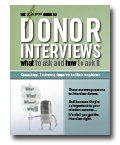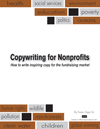A Clickz blog post by Sam Decker, How to Make Customer Content Go Multichannel, has many points that apply equally to the nonprofit sector.
Decker points out how much consumers trust and rely on the opinion of other consumers when making buying decisions. And how few companies leverage that trusted consumer generated content (i.e., product reviews), for effective multi-channel marketing.
Again, Decker’s advice will also help your charity or association:
◊ “Consumers rarely buy a product w/o first checking for customer reviews.”
Donors seldom donate without first looking at the charity’s website (65-83% do this). A much smaller percentage check you out with the charity watchdog sites. Although I haven’t seen statistics on it, I’m guessing a significant number also Google your charity to see what pops up. This might include news articles, conversations on the social networks, what’s being said in blogs, and so on.
They’re looking for information on you. It will help your cause to have “donor reviews” appear in the places people search.
◊ “By extending the customer voice across all marketing channels, brands and retailers can drive incredible value from their customers’ opinions. In other words, customer input creates great ad copy.”
Since it’s vital to write donor-centered (or member-centered) copy, using the words of actual donors is a great way to have copy that resonates with other donors. And leverage it in print (e.g., OP-EDs, direct mail, print ads) and in online channels (website, PPC ad and landing pages, social networking sites, email, etc.).
◊ Decker shared examples of how a few for-profit companies are leveraging customer reviews.
For example: “They reinforce the trust our customers have with QVC and help to take our customers one step closer to an experience of shopping with their friends,” said Alex Miller, director of programming at QVC. [Use of customer reviews for TV marketing.]
Today’s donors and members also need to know they can trust your nonprofit. Hearing from peers (i.e., other donors or members) brings them one step closer to donating or joining.
For example: “Northern Tool boosted conversion by 10 percent on an e-mail campaign simply by including customer reviews in the e-mails. When Rubbermaid included a positive customer review on a coupon, redemption rates for the coupon rose 10 percent.” [Email and print examples.]
Wouldn’t it be sweet to boost response or conversion 10% on your next email campaign? Or how about a boost in response with a donor review on a lift note in a direct mail letter?
For example: “When Office Depot added top-rated review language to its paid search ads on Google, it recorded a 196 percent increase in revenues from paid search.” [PPC ad/landing page example.]
If you’re using Google Adwords for acquisition, fundraising, etc., then it is likely that your conversions will increase and your campaigns will be more cost effective with the use of donor reviews.
Decker wraps up his post with five simple principles for using review content across marketing channels. I’ve provided the nonprofit perspective to his 5 principles:
1 – “Work together”: Marketing, fundraising, mail processing, and donor/customer service call center all work together. Everyone strives to get donor reviews and shares them on your Intranet so anyone on your staff can use them. Know what is needed and train people on how to get these donor reviews.
2 – “Choose wisely”: People pay attention to what you promote and highlight with donor reviews. Therefore, highlight those areas you especially want more donors to support, volunteer for, etc. Again, train your staff to ferret out the reviews you need. Examples of areas to highlight include: planned giving, fundraising, and special events.
3 – “Don’t be shy”: Draw attention to the praise from your supporters. Back up the words with numbers whenever possible. For example, “8 out of 10 donors enjoy stories from our mission work in Guatemala the most.” Or, “3 out of 5 donors donated to Haiti relief.” Get your graphic designer to showcase it with bold graphics, or highlight the most glowing words from reviews.
4 – “Keep it short”: On the consumer side Decker says review snippets included in marketing materials should be short – no more than two lines. In many of your nonprofit marketing it’s the same (e.g., emails, direct mail letters, landing pages of PPC campaigns, print or online ads), and it’s probably best to use snippets. In your newsletter you might be able to include more. In any case, just use the content from the donor review that has “punch” and edit out the rambling.
5 – “Get personal”: Here Decker believes you ought to “give the name and location (and/or age) of the reviewer. Showing customers [donors] that the reviewer is “someone like them” is a great way to build trust in the authenticity of the review content.”
Last but not least . . . track your results. See which donor/member reviews produced the best results and leverage them even more.
 Multi-channel marketing is vital to the growth and financial health of your nonprofit. And you can make it more effective by leveraging donor and/or member reviews across all channels.
Multi-channel marketing is vital to the growth and financial health of your nonprofit. And you can make it more effective by leveraging donor and/or member reviews across all channels.
Want to publish a GREAT donor or member review? This guide lays out everything you need to know and how to do it in order to get a great review from a great interview. It starts with the interview.

{ 4 trackbacks }
{ 0 comments… add one now }